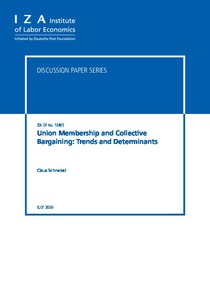Union membership and collective bargaining: trends and determinants

Institute of Labor Economics, Bonn
IZA - Bonn
2020
42 p.
trade union membership ; trade unionization ; collective bargaining ; decentralization
Discussion Papers
13465
Trade unionism
English
Bibliogr.
"This survey shows that union membership and density as well as bargaining coverage have fallen in most countries and that collective bargaining has become more decentralized over the last decades. However, there is a considerable amount of variation across countries and between different indicators of unionization and collective bargaining. Unionization is found to be related to a large number of structural, cyclical, institutional, and socio-demographic variables. Although changes in the sectoral structure of the economy and the composition of the workforce have played a role, their contribution to union decline seems to be smaller than widely believed. The effect of globalization on unionization and collective bargaining as well as the role of changing attitudes of employees towards unions are not fully clear, but the rise of the informal sector in various parts of the world poses a challenge to union recruitment. Union density and bargaining coverage are related, but the link is far from perfect. A more important predictor of bargaining coverage is the level at which bargaining takes place. Bargaining coverage is usually high and stable in countries with multi-employer bargaining, and the decentralization of bargaining structures in many countries has contributed to the fall in bargaining coverage observed in the last decades."
Digital
The ETUI is co-funded by the European Union. Views and opinions expressed are however those of the author(s) only and do not necessarily reflect those of the European Union or the ETUI.